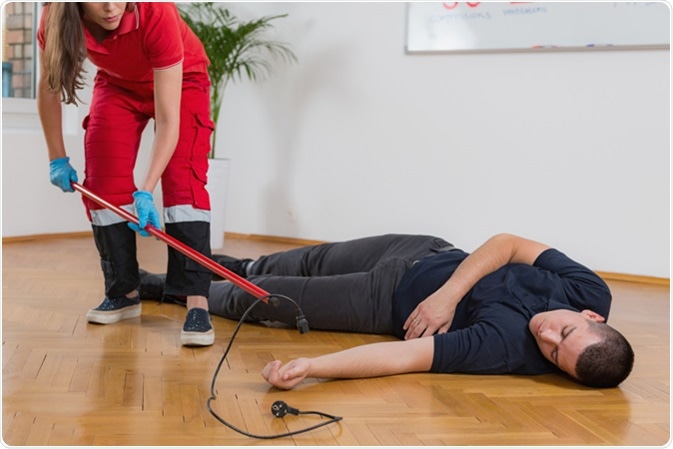An electric shock is a potentially fatal injury. Knowing how to apply first aid to a person who has been electrocuted is important to reduce the risk of severe complications and possibly death.

Image Credit: Microgen / Shutterstock
What is an Electric Shock?
An electric shock happens when a person comes into contact with a live source of electrical energy. It is a physical reaction to the passage of electrical currents through the body. These range from mild reactions to hazardous shocks that can affect the tissues in the body.
The danger of an electric shock depends on how high the voltage is, which part of the body is affected, and the type of current. The physical effects may range from burns to severe internal organ failure, cardiac arrest, and death, in severe cases.
ASHI & MEDIC First Aid | Electrical Shock
Causes of an Electric Shock
Many individuals are at increased risk of high voltage shock or electric shock. It is mostly children, teenagers, and adults who are prone to this condition due to work exposure, man-made electrical items, and mischievous exploration.
Low voltage electricity usually does not cause serious injuries to humans. On the other hand, high voltage electricity (more than 500 volts) may result in serious tissue damage.
Among children, however, significant injuries may occur when exposed to a low voltage of about 110 to 220 volts, which is found in typical household current. They may be electrocuted by household appliances, extension cords, and electrical cords.
Signs and Symptoms of an Electric Shock
The physical effects of an electric shock on the body depend mainly on four factors:
- The amount of current that flows through the body
- The path the current takes through the body
- The amount of time the current remains flowing through the body, and
- The frequency of the current
The physical effects of an electric shock depend on the amount of current. Current of below 1 milliampere does not cause any physical effect. The person may feel a faint tingle from a 1 milliampere current and a slight shock from a 5 milliamperes current. However, for currents between 6 and 25 milliamperes, the patient may feel a painful shock and some loss of muscular control.
Electrical currents between 50 and 150 milliamperes may cause respiratory arrest, severe pain, and severe muscular contraction. In some cases, death is possible. For patients exposed to currents between 1,000 to 4,300 milliamperes, death is likely as the patient may experience nerve damage, muscular contraction, and cessation of the rhythmic pumping action of the heart.
Exposure to currents of as much as 10,000 milliamperes may cause severe burns and cardiac arrest. Death is probable.
The most common signs and symptoms include:
- Loss of consciousness
- The difficulty of breathing or cessation of breathing
- Burns occurring where the current entered and left the body
- Cardiac arrest
- Weak and erratic pulse or cessation of pulse
Electric Shock: What to do
The first step to do is to disconnect the power supply. Turn off the electricals supply, unplug the machine, or switch off the fuse box, if within reach. Don’t attempt to touch the victim until you’re certain the power supply is turned off.
Be careful in areas that are wet such as bathrooms, pool areas, and wet grounds. Water is an electrical conductor and you may get electrocuted. If you’re uncertain about wet grounds, make sure the main electricity supply of the house or building is turned off.
If turning off the power supply is not possible, use a material that does not conduct electricity to separate the person from the electrical source. You can use a wooden broom handle or any dry wooden objects.
As soon as the victim has been freed from the electrical source, call for an ambulance or medical help if you are alone with the patient. While waiting for the ambulance, apply first-aid.
First assess the person’s condition. Check whether the patient is conscious and breathing. In severe cases, the patient may have a weak or no pulse. Breathing may have stopped.
If the person is unconscious and has stopped breathing, begin cardiopulmonary resuscitation (CPR). Position your hand in the center part of the chest, about a couple of inches above the end of the breastbone. Lay one hand on top of the other. Push hard and fast to about a third of the chest diameter. Give 30 compressions.
After each set of chest compressions, give two rescue breaths. Do this by tilting the head back and lifting the chin. Pinch the nose shut and create a complete seal. Blow into the patient’s mouth and see if the chest will rise.
Keep doing sets of chest compressions and rescue breaths until medical help arrives, an AED is available, or the person is breathing. Place the patient in a recovery position if he or she is already breathing. You can prevent shock by laying the patient flat on the ground, with the head slightly lower than the body.
If the person is conscious and breathing is normal, and if burns are present, cover with ordinary cling wrap or other non-adhesive dressing, but no ointment or lotion. If the person fell from a height, do not move. If bleeding is present, compression and a tourniquet may be necessary.
An electric shock is a potentially fatal injury. Immediate medical attention is important to prevent severe injury and death.
Further Reading
Last Updated: Oct 11, 2022